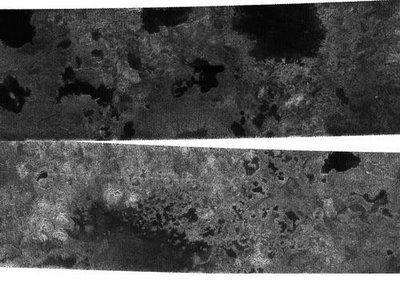Friday, July 28, 2006
This Week at Saturn
 Lots of new posts at the Cassini web page. Scientists attempt to size stones and pebbles on Titan. Remember these things are made of water ice, mostly. Careful about using them for your drink, though. Outside of the midwest's latest heat wave, they'd chill your lemonade rock solid.
Lots of new posts at the Cassini web page. Scientists attempt to size stones and pebbles on Titan. Remember these things are made of water ice, mostly. Careful about using them for your drink, though. Outside of the midwest's latest heat wave, they'd chill your lemonade rock solid.
 Nice shot of the 16-mile wide moon Pan floating amongst the rings, over on the right. It seems the cause of the Encke Gap, that dark band near the outer edge of the ring system. Pan seems to be shedding dust; at least that's the proposed origin for the faint ringlet (not seen here) that shares the gap with the city-sized moon.
Back in 1980, the big news was spokes on Saturn's rings--a totally unexpected sight. When Cassini arrived in 2004, nothing like spokes were to be seen on the rings. Scientists believe a combination of electrically charged dust and the right angle of sunlight are needed. Back in March, University of Colorado astronomers predicted a reappearance this month. They got it right, as this image was posted yesterday:
Nice shot of the 16-mile wide moon Pan floating amongst the rings, over on the right. It seems the cause of the Encke Gap, that dark band near the outer edge of the ring system. Pan seems to be shedding dust; at least that's the proposed origin for the faint ringlet (not seen here) that shares the gap with the city-sized moon.
Back in 1980, the big news was spokes on Saturn's rings--a totally unexpected sight. When Cassini arrived in 2004, nothing like spokes were to be seen on the rings. Scientists believe a combination of electrically charged dust and the right angle of sunlight are needed. Back in March, University of Colorado astronomers predicted a reappearance this month. They got it right, as this image was posted yesterday:
 See the ghostly cloud-like slash a shade down from the center of the picture? That's one spoke. The black band near the outer ring boundary is the Encke Gap, by the way, the home of Pan. The larger dark band was first seen from Earth by the astronomer Cassini in the 17th century, andlike the spacecraft, is named for him.
See the ghostly cloud-like slash a shade down from the center of the picture? That's one spoke. The black band near the outer ring boundary is the Encke Gap, by the way, the home of Pan. The larger dark band was first seen from Earth by the astronomer Cassini in the 17th century, andlike the spacecraft, is named for him.
 Everybody was excited that radar seems to have picked up Titan's elusive lakes. The dark patches are returning no radar signal to the probe, meaning they are smooth as a liquid surface. The thinking is that methane or a methane-ethane mixture have settled in these small depressions. They range from a fraction of a mile to a few dozen miles in width. They'll probably remain a mystery until some enterprising effort lands a probe there.
These lakes are near Titan's north pole, which is currently in the grip of winter. More northern flybys will resolve some of the puzzle, and pick up clues for a few questions: Are these lakes seasonal? How much do they contribute to the orance hydrocarbon smog enshrouding the moon? Are these lakes formed by liquid bubbling up from below or precipitating from above, or both? Could radar pick up waves and ripples from Titan wind?
Everybody was excited that radar seems to have picked up Titan's elusive lakes. The dark patches are returning no radar signal to the probe, meaning they are smooth as a liquid surface. The thinking is that methane or a methane-ethane mixture have settled in these small depressions. They range from a fraction of a mile to a few dozen miles in width. They'll probably remain a mystery until some enterprising effort lands a probe there.
These lakes are near Titan's north pole, which is currently in the grip of winter. More northern flybys will resolve some of the puzzle, and pick up clues for a few questions: Are these lakes seasonal? How much do they contribute to the orance hydrocarbon smog enshrouding the moon? Are these lakes formed by liquid bubbling up from below or precipitating from above, or both? Could radar pick up waves and ripples from Titan wind?